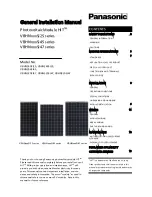
| 20
EN-Rev IM/GN-BM-EU/1.8 Copyright © March, 2021. CSI Solar Co., Ltd.
www.csisolar.com
7.0 MAINTENANCE
Do not make modifications to any component of the PV
module (diode, junction box, connectors or others).
Regular maintenance is required to keep modules clear
of snow, bird droppings, seeds, pollen, leaves, branches,
dirt spots, and dust.
Modules with sufficient tilt (at least 15°), generally may
not require cleaning (rain will have a self-cleaning
effect). If the module has become soiled, wash with
water and a non-abrasive cleaning implement (sponge)
during the cool part of the day. Do not scrape or rub dry
dirt away, as this may cause micro scratches.
Snow should be removed using a soft brush.
Periodically inspect the system to check the integrity of
all wiring and supports.
To protect against electric shock or injury, electrical or
mechanical inspections and maintenance should be
performed by qualified personnel only.
8.0 Module Cleaning Guidelines
This manual covers the requirements for the cleaning
procedure of Canadian Solar ‘s photovoltaic modules. The
purpose of these cleaning guidelines is to provide general
information for cleaning Canadian Solar modules. System
users and professional installers should read these
guidelines carefully and strictly follow these instructions.
Failure to follow these instructions may result in death,
injury or damage to the photovoltaic modules. Damages
induced by inappropriate cleaning procedures will void
Canadian Solar warranty.
SAFETY WARNING
Cleaning activities create risk of damaging the modules
and array components, as well as increasing the
potential electric shock hazard.
Cracked or broken modules represent an electric shock
hazard due to leakage currents, and the risk of shock is
increased when modules are wet. Before cleaning,
thoroughly inspect modules for cracks, damage, and
loose connections.
The voltage and current present in an array during
daylight hours are sufficient to cause a lethal electrical
shock.
Ensure that the circuit is disconnected before starting
the cleaning procedure as contact with leakage of
electrically active parts can result in injury.
Ensure that the array has been disconnected to other
active components (such as inverter or combiner boxes)
before starting with the cleaning.
Wear suitable protection (clothes, insulated gloves, etc.).
Do not
immerse the module, partially or totally, in
water or any other cleaning solution.
HANDLING NOTICE
Use a proper cleaning solution and suitable cleaning
equipment.
Do not
use abrasive or electric cleaners on the
module.
Particular attention should be taken to avoid the
module rear glass or frame to come in contact with
sharp objects, as scratches may directly affect product
safety.
Do not
use abrasive cleaners, de-greasers or any
unauthorized chemical substance (e.g. oil, lubricant,
pesticide, etc.) on the module.
Do not
use cleaning corrosive solutions containing
hydrofluoric acid, alkali, acetone, or industrial alcohol.
Only substances explicitly approved by Canadian Solar
are allowed to be used for cleaning modules.
Canadian Solar recommends to avoid rotating brush
cleaning methods, as they could create micro-cracks in
the PV modules.
Dirt must never be scraped or rubbed away when dry,
as this will cause micro-scratches on the glass surface.
OPERATION PREPARATION
Noticeable dirt must be rubbed away by gentle cleaning
implement (soft cloth, sponge or brush with soft







































